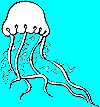 | Beware of the Irukandji Jellyfish Increase in stings in Australia |
 | Beware of the Irukandji Jellyfish Increase in stings in Australia |
|
June 3, 2002 The tropical Northeast coast of Australia is one of the most beautiful areas in the world. However, lurking near the surface of these blue waters is a small but dangerous creature: the Irukandji jellyfish (Carukia barnesi). The Reuters News Agency reported that 200 people have been hospitalized and two people have died this season after being stung by Irukandji jellyfish. Usually only 30 people are sent to the hospital each year for these stings.
Symptoms of "Irukandji syndrome" include:
No one knows what has caused the unusual increase in the number of Irukandji jellyfish stings and at this time, there is no antivenom for the toxin. |
| Did
you know?
|
|
|
References and further information:
|
| GO TO: | Neuroscience In The News | Explore the Nervous System | Table of Contents |
![[email]](./gif/menue.gif) Send E-mail |
 Fill out survey |
 Get Newsletter |
 Search Pages |